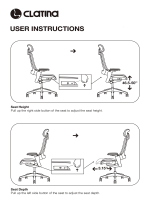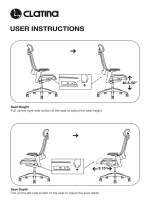
Range6.5.6 31............................................................
Drive-away lock6.5.7 32...............................................
Steering lock6.5.8 33..................................................
Adjusting the driving characteristics6.5.9 34...................
Activating/deactivating the brakes6.6 34......................
Batteries/charging process6.7 36...............................
Safety Instructions6.7.1 36...........................................
General6.7.2 36..........................................................
Battery charging information6.7.3 36.............................
Battery charger6.7.4 37...............................................
Charging the battery6.7.5 38........................................
Power seat functions6.8 39........................................
Safety Instructions6.8.1 39...........................................
Power seat height adjustment6.8.2 41...........................
Power seat tilt6.8.3 42.................................................
Power back angle adjustment6.8.4 43...........................
Power footrests6.8.5 44...............................................
Controlling power seat functions6.8.6 45.......................
Joystick and display functions6.8.7 46...........................
Manual seat functions6.9 47......................................
Safety Instructions6.9.1 47...........................................
Manual seat tilt6.9.2 47................................................
Manual back angle adjustment6.9.3 47..........................
Manual elevating footrests6.9.4 48................................
Additional seat options6.10 48.....................................
Contour seat6.10.1 48...................................................
Recaro® seat6.10.2 49...................................................
Headrest6.10.3 51........................................................
Control unit accessories6.11 52...................................
Attendant control6.11.1 52.............................................
Push-button module6.11.2 55.........................................
Adapter cable for Piko button6.11.3 57............................
External odometer6.11.4 57............................................
Additional options6.12 57............................................
Control panel holder6.12.1 57........................................
Lights6.12.2 58............................................................
Belts / belt systems6.12.3 59..........................................
Suspension (steering casters/drive wheels)6.12.4 61........
Locking the steering casters6.12.5 62.............................
Rear bumper6.12.6 62...................................................
Overview of additional options6.12.7 63..........................
Disassembly/transport6.13 63.....................................
Safety Instructions6.13.1 63...........................................
Reducing the transportation size6.13.2 64.......................
Reducing the transportation size – Recaro®
seat
6.13.3
65...............................................................
Preparing for transport6.13.4 65.....................................
Use in a wheelchair accessible vehicle6.14 66...............
Safety Instructions6.14.1 66...........................................
Permitted use6.14.2 66..................................................
Restrictions for Use6.14.3 67.........................................
Necessary accessories6.14.4 67....................................
4 | Ottobock B500 classic/advanced
Table of contents





















